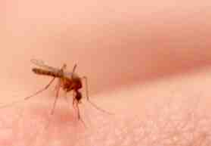
The Spanish called the mosquitoes "musketas," meaning "little fly" The use of the word "mosquito" is apparently of North American origin and dates back to about 1583. Modern writers used the name Culex and it is retained today as the nameof a mosquito genus. What is the correct plural form of the word mosquito? In Spanish it would be "mosquito's," but in English "mosquitoes" (with the "e") is correct.
Mosquitoes can be an annoying and a serious problem in our community. They interfere with work and spoil hours of leisure time. Some mosquitoes are capable of transmitting diseases such as Malaria, Dengue, and Encephalitis and the West Nile virus to humans and animals. The Environmental Health Department is committed to decreasing the level of disturbance in our lives cause by mosquitoes.
Mosquitoes have four separate and distinct stages of its life cycle: Egg, Larva, Pupa, and Adult. Each of these stages can be easily recognized by its special appearance.

The egg stage is the embryonic phase of a mosquito's life cycle. When first deposited, mosquito eggs are white, however within a couple of hours they darken. They are 0.02 to 0.04 inch in length. Standing water species lay their eggs singly or in "rafts" comprising of dozens of eggs on the surface of shallow bodies of standing water. Floodwater mosquitoes lay their eggs singly out of water, but in locations where flooding waters may reach them. Those eggs hatch when their sites are flooded.
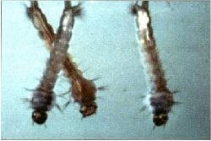
Sometimes referred to as "wigglers" the larval stage is the mosquito's growth and development phase. They elongate growing to more than 1/2 inch at maturity. The larval phase of a mosquito's life cycle is entirely aquatic. The length of this stage depends on the species, the temperature and the available food supply. It may range from as little as five days to one month or longer. It is in this stage larvicides, such as B.t.i. Briquets, may be used to prevent the mosquito from reaching adulthood.
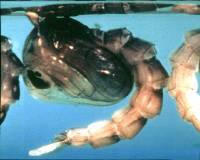
Pupa stage: Mosquito pupae are shaped like commas, with the front region of the body being enlarged. This area is composed of the head and thorax. The lower portion is composed of several freely movable segments, which makes up the abdomen or tail. Generally, pupae will rest near the surface of the water. Depending on the temperature and the species involved, the pupal stage may last from 1 day to 1 and 1/2 weeks or longer.
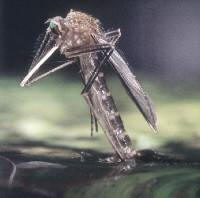
The reproductive phase of mosquitoes occur in the adult stage. Male mosquitoes emerge anytime from a few hours up to a few days before the females hatch, During this period the males will rest on the vegetation surrounding the site. Mating will occur within 48 hours after the females emerge. Adults will vary from 0.06 to 0.5 inch long. Males may be identified by the long, dense sets of hairs and bristles on their antennal and mouth parts. Males will feed on nectar and other sources of liquid carbohydrates. Females will feed on the same foods as a source of energy. However, the females of many species, particularly those of public health importance will require a blood meal as a source of the proteins required for developing eggs. During "mosquito season" females spend their time divided between searching for blood meals, developing eggs and locating suitable egg-laying sites. They may live up to a month or even longer while repeating this cycle. Over periods of inactivity female mosquitoes will seek out resting sites which are humid, dark (shaded) and cool. Many will rest inside of homes or other buildings if they become available.
WHEN & WHY DO WE SPRAY
Mosquito Control can be divided into three parts:
Surveillance: tells us what type of mosquitoes are present and any changes in mosquito population at any given time.
Larviciding: is the application of chemicals to water to kill the larval before they develop into mosquitoes.
Adulticiding: is the spraying of insecticides to kill adult mosquitoes.
We used the following methods to determine whether or not to apply adulticide.
1.We conduct informal surveys, using complaints and surveillance using traps positioned through the county.
2. Another method is landing rate counts. If the count is greater than 5 we will begin adulticiding. An advantage to using landing counts as a sampling device is that you are counting only biting mosquitoes.
3. High wind and warm air currents affect spraying (adulticiding). We will not spray when the wind speed is greater than 25 miles per hour.
4. We also spray for the following events:
a. Funerals
b. Sports events
c. Large parties
Even when mosquitoes are determined to be in an area, spraying must be timed so it will be the most effective. To prevent unwanted drift, spraying usually occurs during late afternoons and/or early mornings. At those times there is an air temperature inversion and air movement is usually at its lowest. It is also when most mosquitoes are at their activity peak.
Remember the effects of spraying are temporary because the mosquitoes from untreated areas can move into a treated area after a spray application. Also, earlier stages of growth are rarely affected by spraying.
Malathion and Biomist are the insecticides we use.
Larvicide tablets are
available for use in standing water, such as ponds. These tablets may be picked up free of charge by Aransas County residents at the Environmental Health Office, 870 Airport Rd, Rockport, Texas during the hours of 8 am through 1200 and 1230 through 5pm Monday through Friday, excluding holidays.
LOCAL SKEETERS
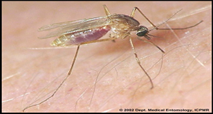 The Culex Species is small, brownish in color and active only at night. It breeds in standing water and is common in underground storm drainage and around houses built on piers. One species is capable of transmitting St. Louis Encephalitis if it becomes infected. The Culex Species is small, brownish in color and active only at night. It breeds in standing water and is common in underground storm drainage and around houses built on piers. One species is capable of transmitting St. Louis Encephalitis if it becomes infected.
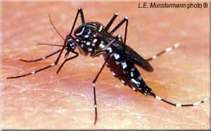 The Asian Tiger Mosquitoes (Aedes) has become the #1 urban mosquito in the south. It is a small black mosquito with sliver bands on its legs and a white stripe on its back. Its peak activity period is during the middle of the day. Breeding sites includes stumps, cans, tires, birdbaths, anything that will hold water. The most effective control method is removal of breeding sites by the property owner. Infected mosquitoes are capable of transmitting Dengue Fever. The Asian Tiger Mosquitoes (Aedes) has become the #1 urban mosquito in the south. It is a small black mosquito with sliver bands on its legs and a white stripe on its back. Its peak activity period is during the middle of the day. Breeding sites includes stumps, cans, tires, birdbaths, anything that will hold water. The most effective control method is removal of breeding sites by the property owner. Infected mosquitoes are capable of transmitting Dengue Fever.
 Saltmarsh Mosquitoes (Aedes taeniorhychus) are small to medium in size, brown and also have white bands on their legs. They are attracted to house and city lights. Saltmarsh Mosquitoes (Aedes taeniorhychus) are small to medium in size, brown and also have white bands on their legs. They are attracted to house and city lights.
WEST NILE INFORMATION
West Nile virus is a mosquito-borne virus that can cause encephalitis or meningitis in humans and other animals. West Nile virus is spread through the bite of infected mosquitoes. Often these mosquitoes become infected after biting infected birds. Birds most likely to become infected are crows and blue jays, neither of which is common in this area. In areas where West Nile virus has been detected, only a small proportion of mosquitoes are likely to be infected. Most people bitten by an infected mosquito do not become sick. Less than 1% of people who are infected will become seriously ill and only 10-15 percent of those seriously ill die.
ADDITIONAL RESOURCES REGARDING WEST NILE
West Nile Outbreak Maps (External Site)
Information Sheet (requires PDF Reader)
HOW TO PROTECT YOUR HOME
The one thing that all mosquitoes require in completing their life cycle is water. If people can manage standing water, we can manage mosquitoes.
While managing mosquitoes is easier (written) said than done the following suggestions are helpful in controlling the mosquito population on your property.
1. Empty, remove, cover or turn upside down any receptacle that would hold water- particularly old bottles and cans.
2. Change water and scrub vases holding flowers or cuttings twice each week, or grow cuttings in sand.
3. Discard old tires or store them indoors.
4. Screen rain barrels and openings to water tanks or cisterns. Seal cisterns not in actual use.
5. Connect open wastewater drains to a sewage system, or construct separate sump or leach lines.
6. Clean clogged roof gutters and drain flat roofs.
7. Fill holes in trees with sand or mortar, or drain or spray them as required.
8. Stock ornamental ponds with mosquito eating fish.
10.Clean and drain evaporative coolers frequently.
*GET RID OF STANDING WATER!*
Integrated Mosquito Management (IMM)
Often mosquito abatement programs are referred to as "Mosquito Control". And just as often residents and professionals alike ask " Are we controlling the mosquitoes or are they in control?" Regardless of its size every mosquito program has a common goal, to maintain mosquito populations at levels so diseases are not transmitted and residents and visitors are not annoyed significantly.
In order to achieve those goals on a continuous basis the principles of integrated mosquito management must be successfully carried out by each of us resident, visitor and environmental health professional alike.
Integrated mosquito management programs use the following combination of techniques aimed at eliminating mosquito producing habits, controlling the growth of mosquitoes and controlling adults.
Surveys and Surveillance
Surveys reveal the mosquito species involved, any associated risks, their population levels, sources and harborage sites, and the effectiveness of the program. To assist in collecting this data the Environmental Health Department has positioned several mosquito traps through Aransas County. Samples are taken weekly, either on Monday or Tuesday. Collecting samples on these days will permit shipment to the state lab without difficulty or consequences. Lab technicians will perform identification of the species submitted and determine if any of the samples are infected with the West Nile Virus. On the day trapping is performed spraying will not occur in order prevent the sample levels from becoming askewed.
Source Reduction Tactics
This involves altering the environment in order to prevent the mosquito from completing its life cycle. Here are some things that you can do:
- Managing land and water by grading, leveling and draining so water will not will not stand for more than 3 days on any one spot. *Preventing immature mosquitoes from further development.
- Clearing vegetation from roadside, sewer and other types of drainage so the water drains out quickly and completely. *Eliminates potential breeding sites.
- Fluctuating water levels in impounded bodies of water such as small ponds or fountains. *Once the water level is decrease it may strand larvae and pupae out of the water they require for further development.
- Designing and maintaining water-holding structures, such as impoundments, so that shorelines and banks are steep-sided, clean of vegetation and open to wind and wave. * Eliminating or minimizing them as sources.
- Remove and properly dispose of unnecessary artificial containers such as old tires, buckets, cans and any other collection items. *Eliminating or minimizing them as sources.
- Overturn water containers such as wading pools when they are not in use.
- Store unused flower pots indoors. Eliminating or minimizing them as sources.
- Store boats, wheelbarrows and large toys in methods that do not collect water. Eliminating or minimizing them as sources.
- Change water and scrub vases, flower pots, pet dishes and birdbaths weekly.
- Maintain rain gutters in properly operating condition. Eliminating the collection of water.
- Fill in holes and depressions in flower beds, trees and on lawns. Eliminating or minimizing them as sources.
*Some source reduction tactics can affect organisms other than mosquitoes. They can also affect the use of use of the water and land for wildlife. Therefore before using a tactic, determine if it will have unreasonable side effects.*
Biological Tactics

- Mosquito-eating fish can be introduce into garden pools and some other types of pools of water. Gambusia affinis has been used effectively for such control.
- Larvicides such as B.t.i.s may be used in ditches, small ponds and small areas of pooling.
- Natural control agents such as birds, bats, certain predatory insects and spiders should be preserved and protected.
*When using biological tactics ensure the method being used at a given site are in accordance with local, state and federal laws.*
Chemical Tactics
- Chemical tactics such as adulticiding will be used by the Environmental Health Department as environmental conditions dictate what chemicals can be used and when they may be safely deployed.
- To avoid increasing resistance and other negative effect on the environment, chemicals used to control mosquito populations only as needed and as indicated by accurate survey information.
- Chemical repellants may be applied mainly to protect individuals, who apply the chemicals to their body or clothing. Remember "Follow the label".
- Candles and oils may have chemicals added to them, which release active ingredients in vapors as they burn. The effectiveness of the methods depend the size of the area and the protection from wind.
Environmental Modification
- At times adult mosquitoes may be discouraged from living near humans, livestock or pets if resting sites are removed. You may deter them by removing dense shrubbery, tall grass and weeds.
- Landscape areas in ways which allows air to flow freely and sunlight to enter.
- Discourage the harborage of birds and animals which may attract mosquitoes in search of blood meals.
- Consider changing outdoor activities to times and locations when decrease levels of interactions with mosquitoes are likely.
Physical Controls
- Protection may be accomplished by placing screens on windows, doors,vents or other openings.
- Mosquitoes are attractive to light. Use dichroom yellow lights near doorways at night in order to make them less attractive to mosquitoes. Place lights away from doors and windows.
- If insect electrocuter light traps or similar devices are used, placed them away the area being protected.
- * Wear light-colored clothing which covers most of the body
|